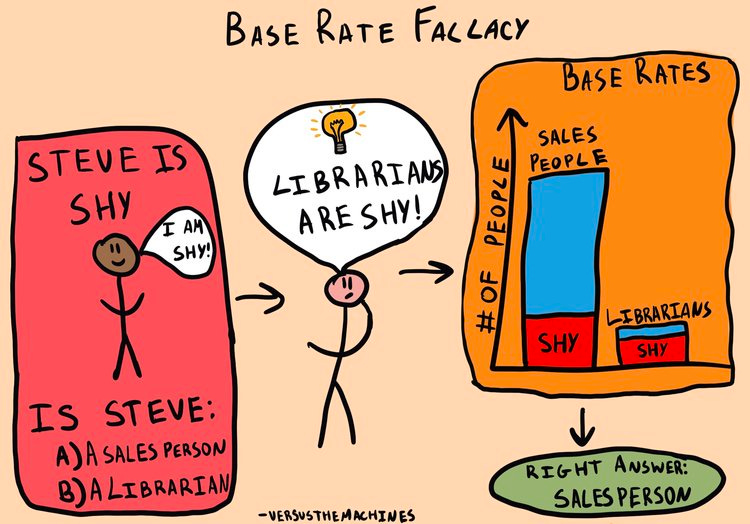The Base Rate Fallacy: When Ignoring the Big Picture Leads to Bad Decisions
How Focusing on Specifics Can Trick Even the Smartest Analysts
Imagine you meet a quiet, introverted man who loves reading and enjoys solitude. Someone asks you:
Is he more likely to be a librarian or a salesperson?
Most people instantly think: "Librarian, of course!" But mathematically, that’s probably wrong.
This is the Base Rate Fallacy in action—a cognitive bias where we ignore general probabilities (base rates) and focus too much on specific details (like personality traits).

Breaking Down the Base Rate Fallacy
In the U.S., there are:
This means that for every 1 librarian, there are about 100 salespeople. So even if only 10% of salespeople are introverted, that still means there will be at least 10 times more shy salespeople than all of the librarians:
Thus, even if Steve fits the librarian stereotype, he's still far more likely to be a salesperson simply because there are so many more salespeople. So if you meet a random shy person, they’re statistically far more likely to be a salesperson than a librarian—even if they seem like a librarian!
Real-World Implications
Ignoring base rates leads to bad decisions across industries:
Financial Markets: An investor notices a particular tech stock has surged by 150% in the past month. The investor becomes fixated on this recent growth, disregarding data showing that most similar stocks experience significant declines after rapid rises. By ignoring these base rates, the investor risks substantial financial losses due to overestimating the stock's potential.
Medical Testing: A patient undergoes a screening test for a rare disease. The test boasts a 95% accuracy rate and returns a positive result. While the test is highly accurate, the disease's prevalence is only 1 in 1,000 people. Without considering this low base rate, one might assume the patient likely has the disease. However, statistically, the probability of actually having the disease given a positive result is much lower due to the high number of false positives in a large population.
Public Perception of Risks: Dramatic events like airplane crashes receive extensive media coverage. This leads people to overestimate their likelihood. In contrast, common risks like car accidents receive less attention, causing underestimation of their prevalence. This misperception arises from neglecting the base rates of these events.
Avoiding the Base Rate Fallacy
To avoid being fooled:
Always Check the Base Rate: Before making conclusions, look at how common something is in the general population.
Use Bayesian Thinking: Update probabilities based on both prior knowledge and new evidence instead of relying on stereotypes.
Don’t Trust Stereotypes Blindly: Just because someone looks like a librarian doesn’t mean they actually are one. Consider the numbers.
By recognizing the Base Rate Fallacy, analysts and decision-makers can avoid statistical illusions and make smarter, more accurate choices. Because sometimes, the obvious answer is the wrong one—if you ignore the math.




